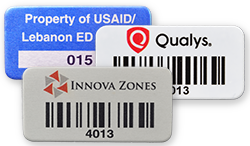Tough Enough for All Your Stuff
Economically Priced with Satisfaction Guaranteed
Super Fast Delivery
 View Gallery
View Gallery
 View Gallery
View Gallery

In the early days asset management was simple. Ugg knew that Tork had his flint knife and that was that.
Ugg was skilled and villagers asked him to do many tasks. He acquired a stone ax and wheel to do the work. Between projects he loaned out his tools.
When Tork lost a flint adze, Ugg decided to scrawl his name on each tool. On a stone tablet he inscribed who had which tool or to which project it was allocated.
Ugg was resourceful and became prosperous. He accumulated many tools and took on increasingly complex projects. When bidding on a new project Ugg needed to know the availability of his tools, which were scattered amongst many jobs and often lost, misplaced or stolen. It became increasingly apparent he needed an asset management system.
Luckily the Iron Age came along. Metal property labels were permanently affixed to each tool. Ugg discovered that his employees took better care of tools with asset tags, and that tool loss decreased dramatically.
Tork was assigned to track Ugg's assets. He slogged around with a stone barcode scanner reading asset tags and entering the tool's name and description into the database. He also recorded the location, condition and normal usage of each asset. Day in and day out Tork the Property Manager monitored tools coming and going from job sites. When something turned up missing it could be traced to a specific day, an isolated task or a certain individual. An assessment of loss, theft or accidental destruction could be made and acted upon legally or financially.
Tools wore out or broke and Ugg decided to add warranty information and service records. The database also contained contact numbers for repair facilities. Stone axes and flint knives returning from service needed to be calibrated and this data was recorded to determine when tools should be tuned up again.
As his business expanded, Zub the Accountant convinced Ugg that adding the acquisition date and value of each tool would save time and help to reduce taxes. Complicated calculations could be automated to determine real expenditure. Some jobs required many tools, or resulted in greater wear and tear, shortening the life of the asset. Opportunity costs of assigning assets to projects could be assessed in great detail. All this information was compiled to assess which projects had the greatest profitability.
In the long run it could be determined how often tools would need to be replaced, and with the detailed price and parts information in the database a comparison could be made between repairing, upgrading or replacing tools.
Ugg was a scrupulous manager. A skilled workforce, excellent customer service and carefully managed assets were his keys to success. Like his primitive but effective tool collection he soon began to acquire and track businesses, maximizing profits with time-tested systems and economies of scale. His multi-national conglomerate was built on the humble asset tag which ties a tool to a wealth of useful information. For many companies, asset tags are the missing link in an effective asset management program.